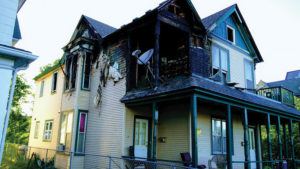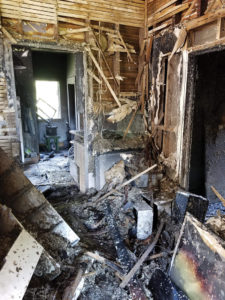Minnesota NAMI office moves near Fairview/University light rail station
By TESHA M. CHRISTENSENA new location means the National Alliance on Mental Illness (NAMI) – Minnesota has more space for classes and training to help people dealing with mental illness.
NAMI moved its offices from 800 Transfer Rd. near the Amtrak train station to 1919 University Ave. W., Suite 400 in March, and staff members have been enjoying the larger, better-lit location.
Plus the office is just a few blocks from the Fairview and University light rail station, which makes it easier for both staff and others to use public transit to get to NAMI, pointed out NAMI Minnesota Executive Director Sue Aberholden.
 Photo
left: NAMI moved its offices from 800 Transfer Rd. near the Amtrak
train station to 1919 University Ave. W., Suite 400, in March, and staff
members have been enjoying the larger, better-lit location. (Photo
submitted)
Photo
left: NAMI moved its offices from 800 Transfer Rd. near the Amtrak
train station to 1919 University Ave. W., Suite 400, in March, and staff
members have been enjoying the larger, better-lit location. (Photo
submitted)There’s also parking behind the building for those who come by vehicle.
Ramsey County Mental Health Center is also located in the same building. Plus, common spaces are shared with ASPIRE Minnesota, an organization that provides children’s mental health services.
Perkins + Will of Minnesota designed the interior space, while the FR Bigelow Foundation helped pay for new cubicles.
“I encourage people who are in the neighborhood to stop by,” stated Aberholden. “We have lots of resources. Check our website for upcoming classes.
“We are a great resource for the community, and we want people to use us.”
 Photo
right: Sue Aberholden has worked at NAMI for almost 17 years, and she’s
focused on disability-related issues for her entire career. “I’ve
stayed because I can see how every day our organization makes a
difference,” stated Aberholden. (Photo submitted)
Photo
right: Sue Aberholden has worked at NAMI for almost 17 years, and she’s
focused on disability-related issues for her entire career. “I’ve
stayed because I can see how every day our organization makes a
difference,” stated Aberholden. (Photo submitted)Making a difference every day
Aberholden has worked at NAMI for almost 17 years, and she’s focused on disability-related issues her entire career.
“I’ve stayed because I can see how every day our organization makes a difference,” stated Aberholden.
Like many other NAMI employees, she has family members who live with depression and anxiety. Through that, she knows the importance of treatment and community support.
What is mental illness?
Every year, NAMI Minnesota serves over 160,000 people across the state through advocacy, education, and support. NAMI does not provide treatment, but the organization hosts the annual NAMIWalk, Spring Gala, and educational conferences. Staff members give presentations and provide resources to increase awareness and promote understanding of people living with mental illnesses.
What is a mental illness?
“Basically it’s a medical condition that affects 1 in 5 adults that affects a person’s feelings, thinking or mood,” explained Aberholden.
The number one diagnosis is anxiety, followed by depression, bipolar, schizophrenia, eating disorders, and personality disorders.
Mental illness can affect people of any age, race, religion or socioeconomic status. Mental health disorders account for more disability than any other illness, including cancer and heart disease, according to the Centers for Disease Control and Prevention (CDC).
It doesn’t only affect adults, either.
Four million children and adolescents in the United States suffer from a serious mental disorder that causes significant functional impairments at home, at school, and with peers.
“Half of all mental health issues appear before age 14,” observed Aberholden. “If we keep thinking it’s an adult issue we miss the boat.”
30 classes
Education and public awareness play an integral role in NAMI Minnesota’s mission to improve the lives of children and adults with mental illnesses and their families through changing public attitudes associated with mental illness.
NAMI Minnesota offers over 30 different classes and provides vital information about mental illnesses, treatment, and resources through publications, presentations, and newsletters.
Classes are offered throughout the state, and NAMI’s 30 staff members are on the road quite a bit.
Some classes help family members learn how to help their loved one. Others focus on suicide prevention and mental illness in the workplace.
A support group for those dealing with anxiety uses the book, “Embracing the Fear” to go over strategies people can use themselves.
Teens are taught to recognize mental illness in themselves and others. NAMI has found that peer support groups work best for teens who share their life experiences and help others.
One of NAMI’s most popular classes is Mental Health First Aid. “A lot of people have learned first aid over the years,” pointed out Aberholden. Learning Mental Health First Aid is the next step.
“It’s all of us working together that will help,” she said.
Another popular offering is the 12-week Family-to-Family class for those with a family member dealing with mental illness.
This year, the State Fair has designed Mon., Aug. 27, as its first Mental Health Awareness Day. The event will include mental health and wellness resources through inspiring stage performances, music, demonstrations, yoga, information, and more.
Over 4,000 people attend NAMI’s Annual Walk, set for Sept. 22 this year at Minnehaha Park. There is no registration fee. “It’s a really uplifting and joyful event,” stated Aberholden.
Suicides have doubled
NAMI staff members go into schools to provide the national Ending the Silence program and have reached over 9,000 students in Minnesota through the one-hour health class. Staff members often offer evidence-based suicide prevention training to teachers before the class so that they are prepared to answer questions from students who start conversations afterward.
Aberholden wants people to know that it is okay to ask if someone is suicidal, and that doesn’t mean you are “planting a seed.”
However, research has shown that discussions and news articles about exactly how someone committed suicide are contagious and should be avoided.
“The number of suicides using the means Robin Williams did increased dramatically after his death,” she pointed out.
Suicides have been increasing nationally and statewide. In 2001 in Minnesota, there were 400 people who committed suicide. That number has jumped to 800.
“It’s a public health crisis that isn’t going away,” stated Aberholden.
Get help
Last year, over 4,000 people were helped through the NAMI Helpline at 1-888-NAMI-HELPS or namihelps@namimn.org. NAMI guides people who are trying to navigate the mental health system and identifies resources and treatment that can help.
For parents who feel isolated and overwhelmed by their child’s behaviors, NAMI offers a Parent Email Warmline. Email parent.resources@namimn.org to connect with a parent peer specialist.
 Photo
left: Over 4,000 people attend NAMI’s Annual Walk, set for Sept. 22
this year at Minnehaha Park. There is no registration fee. “It’s a
really uplifting and joyful event,” stated Aberholden. (Photo submitted)
Photo
left: Over 4,000 people attend NAMI’s Annual Walk, set for Sept. 22
this year at Minnehaha Park. There is no registration fee. “It’s a
really uplifting and joyful event,” stated Aberholden. (Photo submitted)Since April, a text-based suicide prevention service has also been available. People who text MN to 741741 will be connected with a counselor who will help defuse the crisis and connect the texter to local resources. Crisis Text Line is available 24 hours a day, seven days a week.
The Mobile Mental Health Crisis Teams can also be valuable in trying to decide whether or not someone needs more assistance, according to Aberholden. “They can provide advice on the phone, come to someone’s house and offer stabilization,” she said.
This is a good option for those who don’t need hospitalization but need help. Each county has a different line to call; find a list on NAMI’s website.
Misconceptions
NAMI staff members hear many misconceptions about mental illnesses.
“People sometimes blame parents, and it’s not okay because illnesses happen,” pointed out Aberholden.
Another misconception is that people aren’t trying and if the person exerted a little more willpower they could get over it. “Serious depression isn’t about willpower,” stated Aberholden. “This is something that isn’t someone’s fault.”
She added, “We wouldn’t do that with other illnesses.” When someone is bleeding, he or she isn’t told to exert a little more willpower to heal.
While well-meaning people often tell loved ones to “reach out if you need me,” that doesn’t always help. “If you’re seriously depressed, you’re not going to do that, so people need to learn how to reach in,” observed Aberholden.
Text and say, “Hey, I’m in the neighborhood. Let’s go for a walk,” she suggested. That has multiple benefits as the exercise also gets the endorphins going in the brain.
“Send get-well cards and bring over a hotdish,” said Aberholden. “We do these kinds of supports for people who have cancer, but we don’t do that for people with a mental illness.”
You don’t see CaringBridge sites for people with mental illnesses, she added. Yet she knows of one man who started one at the urging of his wife. He commented that his hospitalization was tough because the decks of cards were all worn out, and they didn’t stock his favorite soda.
“Every day someone showed up with cards and pop,” noted Aberholden. “It turned into the shortest hospital stay he’d ever had.
“Providing hope for the future is critical.”












